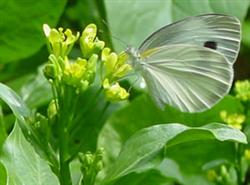Key points in the management of cotton boll opening period
China is a big cotton growing country, which has a large output and low production cost. It can produce all kinds of textile fabrics. It is a necessity in people's life and has high economic value. In order to achieve the high yield of cotton when planting, the management work in the cotton boll opening period is very important, so what about the specific management? Let's take a look.

1. Prevention of drought and flood
Cotton boll opening period generally has about 70 days, generally in late August began to open boll, to the end of October or the beginning of 11 boll opening completed, when cotton entered the period of complete growth and reproduction. The lower part of the plant began to open bolls, while the upper part continued to grow, which was the period of increasing boll weight and improving fiber quality. At this stage, if the climate is dry and the soil is lack of moisture, the boll weight and fiber quality will be reduced, while if there is often overcast and rainy weather, too much water in the soil will lead to rotten bolls, affecting yield and quality. Therefore, the most important thing at this time is to prevent drought and waterlogging, timely watering during drought to maintain soil and water balance, and timely drainage and waterlogging prevention when it is overcast and rainy.
2. Spraying fertilizer to prevent premature senility
After entering the boll opening stage, the temperature decreases, the root absorptive capacity and photosynthesis will decrease, the absorbed and synthesized nutrients can not supply the plant to continue to grow, and it is easy to appear premature senescence. Therefore, it is necessary to apply fertilizer in time, but the root absorption is poor, and the effect of topdressing is poor, so the best way is to spray fertilizer on the leaves to improve the nutritional status of cotton plants and prolong the functional period of leaves to achieve the purpose of increasing production. Foliar fertilizer spraying can be mixed with urea and potassium dihydrogen phosphate into a solution, sprayed every other week, 3-4 times in a row.
3. Pruning and branching
In the cotton boll opening period, the middle and upper part of the plant continues to grow, if not controlled, it will affect the ventilation and light transmittance of the field, but also consume a lot of nutrients. Therefore, strengthening pruning and forking in the later stage can not only improve field permeability, but also reduce nutrient consumption, increase boll weight, promote early maturity and reduce boll rot. During pruning, the old leaves and empty fruit branches in the lower half of the plant were removed, the tips of fruit branches were knocked off, and then the two adjacent rows of cotton were pushed together to form a figure-of-eight shape to increase field permeability.
4. strengthen the prevention and control of diseases and insect pests
Cotton boll opening period is also a period of high incidence of diseases and insect pests, which can easily lead to boll rot and sharply reduce yield, so the prevention and control of diseases and insect pests is a top priority at this time. The disease is mainly boll blight, which can be easily prevented by spraying mancozeb. The infected cotton peach should be picked in time, and then easily soaked with 1% ethephon and then removed to dry. Insect pests are mainly cotton bollworm, white whitefly, red spider and so on, which should be controlled in time.
5. Accelerate ripening and harvest
For late-maturing plants, it is necessary to carry out ripening methods so that they can open bolls normally, so as not to cause greedy green late-ripening phenomenon, affecting yield and quality. Ethephon can be used to accelerate ripening, which is generally sprayed on a sunny day when the temperature is above 20 degrees. In addition, harvest is also an important point, early harvest leads to poor color and low quality, and if it is too late, the fiber degree of cotton will decrease, and the general harvest time is 5-7 days after cracking. When harvesting, it is necessary to distinguish between normal cotton and cotton with rotten bolls, insect pests and other poor quality cotton.
The above are the key points of the management of cotton boll opening period. I hope I can help you. If you want to know more about cotton planting, please follow us.
- Prev

Field Management of Rice in Summer
Field Management of Rice in Summer
- Next

How to cultivate strong seedlings of rapeseed
The scientific name of rape pink butterfly Artogeia (Pieris) rapae (Linnaeus) is Lepidoptera, Pteropteridae. Synonym Artogeiarapae (L.). Alias White Butterfly, White Butterfly. The larvae are called cabbage insects. Distributed all over the country. Host rape, cabbage, cauliflower, cabbage, radish and other cruciferous vegetables.
Related
- The first cup of black tea in spring, the flavor and history of tea gardens in Kenya, Africa
- The computer can not only choose potatoes, but also grow tea rice. AI will grow winter oolong tea champion.
- It is not only the inflated tea bitten by insects, but also engraved with the four seasons tea in Beipu.
- The Oriental Beauty Tea Festival in Zhuxian County takes the stage at the weekend to experience the plus-size feast of oil tea.
- & quot; Oriental Beauty Tea & Exploration of Emei in Hsinchu, the hometown of quot;
- The new variety of strawberry "Tainong 1" dessert is the first choice with mellow aroma. Crimson gorgeous
- History of Tea in Taiwan: from Wild Inner Mountain to Export Tea Garden
- Two types of Taiwan Oriental Beauty Black Tea won the British three-Star Award for Childhood Tea Xiang Zhang Jiaqi changed from pilot to champion tea maker.
- Banana species and varieties: the planting history of Taiwan Xianren banana and dwarf banana is long, is banana disease resistant?
- Coffee planting Technology: Qianjie Coffee from Seedling to harvesting

